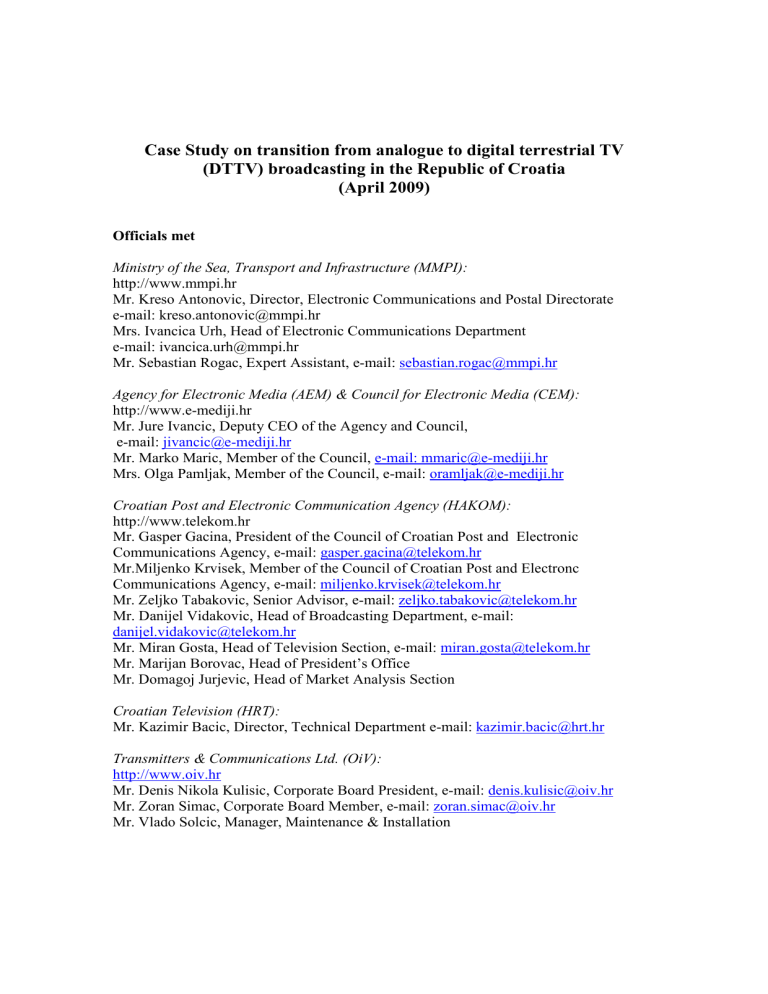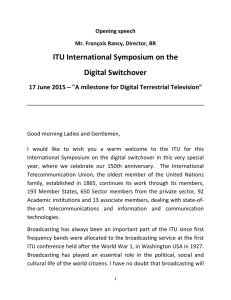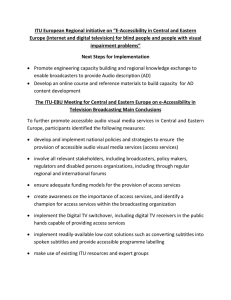Case Study on transition from analogue to digital terrestrial TV

Case Study on transition from analogue to digital terrestrial TV
(DTTV) broadcasting in the Republic of Croatia
(April 2009)
Officials met
Ministry of the Sea, Transport and Infrastructure (MMPI): http://www.mmpi.hr
Mr. Kreso Antonovic, Director, Electronic Communications and Postal Directorate e-mail: kreso.antonovic@mmpi.hr
Mrs. Ivancica Urh, Head of Electronic Communications Department e-mail: ivancica.urh@mmpi.hr
Mr. Sebastian Rogac, Expert Assistant, e-mail: sebastian.rogac@mmpi.hr
Agency for Electronic Media (AEM) & Council for Electronic Media (CEM): http://www.e-mediji.hr
Mr. Jure Ivancic, Deputy CEO of the Agency and Council,
e-mail: jivancic@e-mediji.hr
Mr. Marko Maric, Member of the Council, e-mail: mmaric@e-mediji.hr
Mrs. Olga Pamljak, Member of the Council, e-mail: oramljak@e-mediji.hr
Croatian Post and Electronic Communication Agency (HAKOM): http://www.telekom.hr
Mr. Gasper Gacina, President of the Council of Croatian Post and Electronic
Communications Agency, e-mail: gasper.gacina@telekom.hr
Mr.Miljenko Krvisek, Member of the Council of Croatian Post and Electronc
Communications Agency, e-mail: miljenko.krvisek@telekom.hr
Mr. Zeljko Tabakovic, Senior Advisor, e-mail: zeljko.tabakovic@telekom.hr
Mr. Danijel Vidakovic, Head of Broadcasting Department, e-mail: danijel.vidakovic@telekom.hr
Mr. Miran Gosta, Head of Television Section, e-mail: miran.gosta@telekom.hr
Mr. Marijan Borovac, Head of President’s Office
Mr. Domagoj Jurjevic, Head of Market Analysis Section
Croatian Television (HRT):
Mr. Kazimir Bacic, Director, Technical Department e-mail: kazimir.bacic@hrt.hr
Transmitters & Communications Ltd. (OiV): http://www.oiv.hr
Mr. Denis Nikola Kulisic, Corporate Board President, e-mail: denis.kulisic@oiv.hr
Mr. Zoran Simac, Corporate Board Member, e-mail: zoran.simac@oiv.hr
Mr. Vlado Solcic, Manager, Maintenance & Installation
Central State Administrative Office for e-Croatia(e-Croatia):
Mr. Tomislav Vracic, Head of Department, e-mail: tomislav.vracic@vlada.hr
Mr. Hrvoje Perinic
Strategy for transition
Discussions with the above-mentioned officials have been focused on the Strategy for transition from analogue to digital terrestrial TV broadcasting in the Republic of Croatia.
Total of 47 pages document “Analogue to Digital Television Broadcasting Switchover
Strategy for the Republic of Croatia” has been adopted on 31 July 2008 by the
Government of the Republic of Croatia (hereinafter: The Strategy). Indeed it defines the overall concept of transition from analogue to Digital Terrestrial Television (DTTV) broadcasting in this country and is available in English language. It stipulates fundamental strategic guidelines for the introduction of DTTV in the Republic of Croatia and merits to be attached to this Case Study in its integrity to be made available for wider consultation by ITU Members. Although publicly available, this document may be copied and used in printed and/or digital form, provided that the copyrights are not infringed and that the source and the author are clearly and noticeably cited in each copy of any form whatsoever, and that all deviations from the original are clearly and noticeably marked in each copy, naming the authors of the changed and/or added text segments.
For this reason, comments and findings of the ITU expert conducting this case study will be provided hereinafter, thus retaining the original form of The Strategy document in full.
The Strategy describes clearly defines the strategic decisions taken for the entire process of transition from analogue to digital terrestrial television broadcasting.
Indeed it incorporates every key aspect of it, including basic criteria for The Strategy’s implementation; institutional and legal framework; technical and technological framework covering: frequency planning, coverage, international radio-frequency coordination, applicable standards for coding and transmission of digital terrestrial television signals, licensing regimes, type and number of TV services, start of simulcast and completion of the analogue switchover process for every one of the nine “digital regions” of this country; programme content; service systems and business models; promotion campaign with cost involved; financing and transition cost issues; and last but not least implementation management and monitoring system.
It is worth mentioning that every objective of this strategy is stipulated and coordinated with precision, assigning to relevant stakeholder’s responsibility applicable deadline at every action level without exception.
The main strategic goal ahead of this country is to achieve full digital television switchover by 31st of December 2010 at the latest.
Another two complementary documents have been also adopted in this country, namely:
i) Decision on the start of digital TV broadcast and the end of analogue TV broadcast in the Republic of Croatia and ii) Decision on the manner of distribution of subsidies and criteria and conditions of granting such subsidies to the TV subscribers (natural persons), in order to purchase TV adapters Set-Top Boxes) for the reception of DVB programmes.
As defined in Section 6.1. of The Strategy document the Programme content and other conditions for the provision of television services are regulated by the Electronic Media
Act governing responsibilities, rights and obligations of the Agency for Electronic Media and the Council for Electronic Media (hereinafter the Council).
In principle the Electronic Media Act governs the commercial broadcasting service in this country, the Croatian Radio-Television Act governs the public service broadcasting.
The competence of the Croatian Radio-Television is regulated by the Croatian Radio-
Television Act which in particular stipulates that CRT programmes can be broadcasted in digital.
The aforementioned primary legislation stipulates the obligatory programme content that must be included in broadcasters’ programme plan, defining programme content type and classification into groups, quantitative ratio between individual programme content groups, maximum permitted amount of advertising content, anticipated amount of own programme content and Croatian and European audiovisual content share.
The provisions of the “Electronic Communications Act”, Official Gazette No. 73/2008, govern the Croatian Post and Electronic Communications Agency (HAKOM) and particularly in Chapter XI Digital Radio and Television, govern the delivery and the transmission aspects of digital terrestrial television. Furthermore, in Chapter X they govern radio frequency spectrum management and licensing regimes. Both Article 30, governing the shared use of electronic communication infrastructure and associated facilities, and Article 61, governing the obligation of access to, and use of, special network facilities, offer potential for shared use of facilities for the multiplexes and transmission networks for DTTV broadcasting.
The Electronic Media Agency grants content licenses (concessions) to TV broadcasters valid between 8 and 15 years, and such concession fee can not exceed 60000 Euro.
HAKOM grants licenses to the DTTV broadcasting network operators for the right to use the frequency spectrum. The duration of spectrum usage licenses may be up to 20 years and the fees for use of spectrum can not exceed 270000Euro.
The English version of the Electronic Communication Act will also be attached to this case study for reference.
The primary and secondary legislation, enumerated in Section 4.2. of the Strategy document, particularly stipulates the following:
legal procedure to select network operators,
legal procedure to select new commercial broadcasters to fill the available multiplexes with appropriate programme content,
legal rights for the Croatian Radio-Television to produce and distribute more than two nationwide TV programmes, and
fees for the right to use radio frequency spectrum.
The same Section 4.2. of The Strategy document stipulates that “All current nationwide analogue broadcasters, besides the public service broadcaster, shall have their programmes in the first multiplex at the moment of digital switchover.
It is necessary to ensure that possible amendments to the aforementioned primary legislation do not cause an adverse impact on the market position of any existing content provider, and such the amendments should facilitate television programme receiving for the citizens who currently receive analogue television programmes “.
In conformity with The Strategy, the Ministry of the Sea, Transport and Infrastructure
(MMPI), in cooperation with the Croatian Post and Electronic Communication Agency
(HAKOM), is responsible for the preparation and adoption of the secondary legislation relevant to the introduction of digital television. Upon proposal submitted by the
HAKOM, the Ministry of the Sea, Transport and Infrastructure has adopted on 19 th
of
December 2008 “The Ordinance on Analogue to Digital Radio and Television
Broadcasting Switchover and Access to Multiplex Positions in Terrestrial Digital
Broadcasting” (OG 148/08).
This Ordinance, together with other secondary legislation being enacted in relation to the radio frequency spectrum management, namely the Ordinance on radiofrequency spectrum allocation (OG 136/08) and the Ordinance on radiofrequency spectrum assignment and usage (OG 136/08), provides the legal basis for the introduction of digital television and digital terrestrial television switchover in Croatia.
Market share of platforms
In accordance with latest information provided during the discussions 78,9% of the population receives free to air analogue terrestrial TV broadcasting, and pools suggest that the HTV public service is enjoying the preference of the audience.
In accordance with the information provided by the OiV officials currently HTV programmes are broadcast via analogue network of 370 main and rebroadcast transmitters covering 99% of the population, Nova TV is broadcast via 250 analogue main and rebroadcast transmitters and RTL is served by 170 main and rebroadcast transmitters.
Only 9% of the population are cable TV networks subscribers.
TV Satellite TV Broadcasting service market share is 7,8% and monthly fees applied vary between 5 and 20 Euro.
IPTV has modest market share of only 3,3 %.
DTTV testing and experimental broadcasting has been done for years by OiV with standard definition television using DVB-T and MPEG-2 and recently with high definition television using DVB-T and MPEG-4.
The HRT programmes provided for digital terrestrial broadcasting are on SDI format.
Same as above technology set-up has been tested by the private company Croatel for both standard definition and high definition DTTV broadcasting.
DVB-H technology was tested by the mobile operator VIPnet.
The information obtained from unofficial sources during the mission indicate that MPEG-
2 STB retail price is about 22 Euro, MPEG-4 STB is about 70 Euro, SDTV receiver around 700 Euro and HDTV quality MPEG-2/MPEG-4 receiver retail price is about 1500
Euro. These indicative prices are neither of average nor of statistical nature.
According to the Croatian Radio-Television Act every owner of TV set is obligated to pay subscription fee of 10.57 Euro per month for reception of radio and TV public
Broadcasting Service (PBS). According to the data for the year 2007, originating from the
Central Bureau of Statistics, there were total of 1193509 television subscribers in the
Republic of Croatia (1123098 individuals (households) and 70411 companies and institutions). Based on this data, annual subscription fee income for radio and TV public broadcasting service (PBS) is estimated at 151,4 million Euro.
In addition, PBS can generate substantial income from advertisements, sponsorship and publicity.
Commercial broadcasters operate based on revenue generated by advertisements, sponsorship and publicity only.
Two PBS TV programmes are delivered to 98 % of the population while 22 commercial
TV programmes are delivered 70-95.5 % of the population depending on the coverage as per the concession conditions.
Analogue Switch-Off
The Republic of Croatia de facto has adhered to the European Union Members’ decision at the RRC-06 to switch-off the analogue TV broadcasting by the year 2012.
The Strategy of this country stipulates that the Analogue Switch-Off (ASO) of the terrestrial TV broadcasting shall be done latest by the end of 2010.
The simulcast period, because of its double cost implications, varies between 6 and 11 months.
Chapter 5 Section 5.1., Table 1 of this document provides self explanatory information plus relevant ASO deadlines on the switchover process which shall be progressive and based on regional approach model in all 9 regions of the country.
The switchover process in every region consists of two key activities:
1.
Beginning of the switchover process in a particular region – commencing with nationwide “simulcast” of both analogue and digital broadcasting,
2.
Completion of the switchover process in a particular region – final switch-off of nationwide analogue transmitters, creating prerequisites for digital switchover for all television broadcasters on regional/country and local/town level, and creating possibility for the introduction and development of new, additional electronic communications services.
Table 1 - Time schedule for digital television switchover according to regions
Corresponding Strategy Plan of nine digital regions for the Republic of Croatia is provided in Figure 1 below:
D5 D6
D7
D4
D3
D8
D2
D9
D1
D1 – Osje č ko-baranjska,
Vukovarsko-srijemska
D2 – Bjelovarsko-bilogorska,
Viroviti č ko-podravska, Požeškoslavonska, Brodsko-posavska
D3 – Me ñ imurska, Varaždinska,
Koprivni č ko-križeva č ka
D4 – City of Zagreb, Zagreba č ka,
Sisa č ko-moslava č ka, Krapinskozagorska
D5 – Primorsko-goranska,
Istarska
D6 – Karlova č ka, Li č ko-senjska
D7 – Zadarska, Šibensko-kninska
D8 – Splitsko-dalmatinska
D9 – Dubrova č ko-neretvanska
Figure 1 – Plan of "digital regions" for the Republic of Croatia allocated in accordance with the Digital Broadcasting Plan GE06 and related counties of the
Republic of Croatia
The Strategy stipulates that “Digital switchover shall be implemented on the level of 9 aforementioned regions, meaning that the radio frequency planning and international coordination of the use of the radio frequencies with the neighbouring countries represents basic pre-requisites for drafting the Radio Frequency Allocation Plan for Broadcasting of
Radio and Television Programmes in the Republic of Croatia in the transitional period.”
This Administration believes that the delicate and complex transition process will be successful if properly coordinated in detail not only with neighbouring countries, but also
with any other country concerned. It has been reported that while practical results with some countries have been already achieved towards this end, an outstanding difficulties with two neighbouring Administrations are yet to be ironed out.
Licensing/Authorization schemes
The HAKOM Agency has issued and published call for tenders for licensing of two nation-wide DTTV Broadcasting Multiplexes (MUX A and MUX B) with required population coverage of 95%. The spectrum license will be granted to the successful bidder OiV for 10 years duration, binding the OiV to ensure multiplexing service, mustcarry obligation for existing analogue programmes, 4 to 5 SDTV programmes per multiplex with statistical multiplexing and MPEG-2 coding.
The minimum requirements for MUX A and MUX B data rates in the invitation procedure for tenders has been defined as 19,91 Mbits/s. 64-QAM modulation, 2/3 protection coding and ¼ guard interval already planned has been suggested in the invitation procedure for tenders.
Average net data rate per TV programme will be approximately 4 Mbits/s.
Exact number of TV programmes and the total capacity of MUX A and MUX B will be known after the end of the tendering procedure and granting the license.
Experimental DTTV transmissions in operation ensure coverage as indicated below:
The deadline for applications was fixed at 30 March 2009 and the license decision by
HAKOM shall be announced by the end of April 2009.
In accordance with the Strategy both Multiplexes A and B shall deliver the assigned TV programmes to the population of this country the by the end of the year 2010 at the latest, and they should, as per the Digital Switch-over Timetable, become operational in the course of year 2009.
Cost implications of the transition to digital
Information about cost implications for deployment and operational yearly budget of every multiplex and corresponding transmission network could be obtained after the end of the tendering procedure.
Broadcasting network structure (ownership of multiplex, transmission network)
The current legislation provides opportunities for shared use of electronic communication infrastructure, but decision taken will be known upon completion of the tendering process. At the time of writing this Case Study such information was not available.
Applicable Standards
Taking into account the legacy problem of existing MPEG-2 STB’s and MPEG-2
Integrated TV receivers, the Strategy (Section 5.2.2.) stipulates that the Republic of
Croatia has decided to use for: a) Standard Definition TV – the MPEG-2 / ITU-T Rec. H.262 / ISO/IEC IS 13818
Standard; and for b) High Definition Television and Pay per View broadcasting of TV programmes– the MPEG-4 Part 10 / ITU-T Rec. H.262 AVC / ISO/IEC14496-10:2005
Standard.
In spite of higher retail price of MPEG-4 Set-Top Boxes (STB) - around 70 Euro in this country, - this future-proof strategic decision is taken to use more efficiently the spectrum and provide better technical quality to the population.
In the above-mentioned Strategy Section there is a firm requirement that “the television transmitter network and multiplex capacity must be planned to meet the requirements for high definition television signal (visual and audio).
The implementation of high definition television (HDTV) shall commence with the radio frequencies available at a local level, especially in urban, high density populated areas, according to the "digital islands" model. Subsequently, in accordance with technical possibilities and needs, it will be spread to other areas of the Republic of Croatia. This will create an opportunity for the market and service users to efficiently and timely prepare for future changes and technology upgrades of the television programme broadcasting”.
Discussions with HAKOM have revealed that MUX C has not been decided yet and
HDTV might be assigned in this national Multiplex during the Second Phase of
Transition.
Spectrum Planning
All measures are taken to ensure that this Strategy is in full conformity with the GE-06
Plan and under the envelope concept adopted at the RRC-06.
Multiplexes and Longer-term planning issues
The First Phase will be composed of two national MUX A and MUX B with 5 SDTV free-to-air programmes each.
The Second Phase will be dedicated to commercial broadcasting and be composed of one regional content MUX, one national HDTV MUX, one commercial operation Mobile
TV MUX (DVB-H), and lastly of additional regional/national MUX.
One MUX and corresponding network might be foreseen for HDTV as longer-term objective after the ASO date. It may be practically impossible as for many other
European countries to launch a HDTV offering on the terrestrial platform until they and their neighbours have completed the Analogue Switch-Off.
Technical possibility exists to restructure SDTV into HDTV DTTV service in all DTTV multiplexes should the market be ready for it provided that: a) HDTV attractive programme content is in abundance; b) HDTV quality receivers with screens bigger than 50 inch at affordable prices are dominating the market; c) Terrestrial DHTV delivery still remains more attractive than satellite, cable or
IPTV delivery; d) Blu-ray recorders and players are widely in use; e) Quality of service and robustness of delivery remains outstanding; and f) Last but not least the business plans continue to be successful.
In general for entirely HDTV service with performing MPEG-4 encoders it is possible to expect delivery of 7 to 21 HDTV nation-wide programmes within UHF Bands IV and V, but below 790 MHz.
It is to be noted that after the decision of the WRC-07 the loss of channels 60 to 69 in frequency band 790 to 862 MHz has lead to loss of 1,5 layers/multiplexes at national level and the frequency planning in Croatia takes this outcome into consideration.
Digital Dividend
It is becoming evident that the digital dividend will be generous to this country as evidenced from the extracted from the Strategy figures below indicating available multiplexes and associated broadcasting services and other electronic communications services in VHF Frequency Band III and separately in UHF Frequency Bands IV and V:
For more information kindly refer to Section 6.2. of the attached Strategy document.
Additional benefits from the transition to digital
The Strategy defines the additional benefits to be derived from the transition to digital such as enhanced additional services and applications as well as the interactivity applications to be embedded into the DTTV platform. For more information kindly refer to the attached Strategy document Section 6.2. :
1. Communication services;
2. Information Services; and
3. Interactive services.
Consumer issues
The Central State Administrative Office for e-Croatia was designated as a focal coordinating body responsible for the implementation of a comprehensive informationeducational campaign related to the digital television in the Republic of Croatia.
Section 7. Promotion Campaign and Campaign Costs and the Action Plan given in
Appendix B of the Strategy document assign clear responsibilities to e-Croatia and indeed this Office has demonstrated outstanding achievements towards this end.
It is highly recommended that the reader of this Case Study analyses entirely the said
Section 7. and corresponding Annex B. attached accordingly to this Case Study.
Public Opinion Survey, prepared by Puls d.o.o. for this country in April 2008 provides precious information on the consumer behaviour towards the forthcoming transition from analogue to digital and is also attached to this Study.
Business model and plan
The Strategy in its Section 8. Financing – Cost Framework stipulates the following:
“The transition from analogue to digital television broadcasting in the Republic of
Croatia should be a market-oriented process based on the principles of transparency, nondiscrimination and technological neutrality. The existing satellite and cable digital communications market is a very good example of the development possibilities without an "external intervention". However, the analogue to digital television broadcasting switchover process, whereas the terrestrial television represents the basic television programmes reception technology for the majority of consumers – viewers in the
Republic of Croatia, cannot be successfully implemented without support and coordination from the competent public administration bodies and without ensuring the necessary funding from the state budget, in accordance with the defined public interests.
The following main items of expenditure from the state budget of the Republic of Croatia should be identified by this Strategy for the implementation period of digital terrestrial television:
digital receivers subsidising in a technologically neutral form – pursuant to the decision of the Government of the Republic of Croatia to grant vouchers to natural persons paying RTV fee,
costs of the promotion campaign with the purpose to inform the public, carried out by the Central State Administrative Office for e-Croatia,
management costs of the Strategy implementation (analyses, opinions, public surveys, etc.).
Under the relevant EU legislation, direct governmental subsidies for commercial interests are generally not allowed. Consequently, any additional costs incurred during the analogue to digital television broadcasting switchover must be covered within the limits of funds planned by each stakeholder in this process. When the digital switchover is finished, the overall television programmes transmission costs can be expected to be significantly lower due to the use of digital technology.
Since the Croatian Radio-Television Act obliges, all television and radio set owners on the territory of the Republic of Croatia to pay RTV fee, the Government of the Republic of Croatia shall ensure that in the period of the implementation of this Strategy there is no
group of population which is socially disadvantaged or deprived for any reason during the analogue to digital television broadcasting switchover process.
Governmental subsidies for digital receivers to the citizens – end-users, in accordance with the common practice in EU Member States, shall significantly contribute to the increase in the number of digital terrestrial television services users in the Republic of
Croatia, thus enabling the full digital terrestrial television switchover within deadlines defined by this Strategy – as of 31 December 2010.
The Central State Administrative Office for e-Croatia shall plan within its part of the state budget of the Republic of Croatia the funds required for the aforementioned subsidies.”
However, due account taken of current financial crisis, the amount of Euro to be granted by voucher to each household is defined to be of 10 Euro by decision taken by the
Government of the Republic of Croatia on 12 February 2009..




